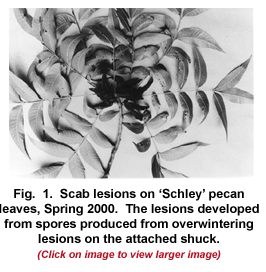 The
drought stricken Spring 2000 was not conducive to pecan leaf scab in Georgia.
In the Albany, Georgia area, only one scab inducing event occurred during
the period of leaf expansion, the stage during which the leaf is susceptible
to scab. The scab inducing event happened during the intermittent rains
of March 29-31. Then, scab generally occurred only under two situations.
One, leaf scab occurred in orchards where scab was a problem on the shoots
during 1999. Scab lesions that developed on the second cycle of shoot growth
overwintered and were the source of inoculum. If these orchards were not
sprayed during Spring 2000, leaf scab was evident throughout the tree canopy.
Two, leaf scab was associated with attached, overwintering shucks (Fig.
1). In this case, the scab was restricted to leaves in close proximity to
the attached shuck. Leaf scab from overwintering shucks was especially noticeable
on scab susceptible 'Schley' and 'Desirable'.
The
drought stricken Spring 2000 was not conducive to pecan leaf scab in Georgia.
In the Albany, Georgia area, only one scab inducing event occurred during
the period of leaf expansion, the stage during which the leaf is susceptible
to scab. The scab inducing event happened during the intermittent rains
of March 29-31. Then, scab generally occurred only under two situations.
One, leaf scab occurred in orchards where scab was a problem on the shoots
during 1999. Scab lesions that developed on the second cycle of shoot growth
overwintered and were the source of inoculum. If these orchards were not
sprayed during Spring 2000, leaf scab was evident throughout the tree canopy.
Two, leaf scab was associated with attached, overwintering shucks (Fig.
1). In this case, the scab was restricted to leaves in close proximity to
the attached shuck. Leaf scab from overwintering shucks was especially noticeable
on scab susceptible 'Schley' and 'Desirable'.
Demaree (Demaree, 1923) regarded overwintering twig lesions as the major source of inoculum for new leaves. During Spring 2000, the distribution of scab throughout the canopy on trees with overwintering twig lesions versus the localized distribution from attached shucks supports Demaree's contention. Demaree's recommendation for the prevention of twig lesions by proper use of fungicide during the period of leaf and shoot elongation (including the second cycle of shoot growth) remains valid.
Although secondary to twig lesions, Demaree considered overwintering, attached shucks to be an important source of new scab infections. Demaree's recommendation was to knock the shucks off the tree in the winter and then burn the shucks. In 1923, knocking the shucks off the tree by hand was feasible as most pecan trees in Georgia were small. Nowadays, the shucks can be knocked off the tree with a mechanical tree shaker. After leaf fall and harvest, trees should be inspected for overwintering shucks and a decision to shake or not to shake should be made. If the decision is to shake, shaking should be done in January. If the shaking is delayed until late February or early March, shucks left in the tree will be more difficult to detect due to decreasing numbers from natural shuck fall that occurs throughout the winter.
Mechanically shaking at harvest removes a high percentage of shucks that would otherwise overwinter on the tree. Consequently, overwintering shucks as a source of new infections in the spring is not as important as before the advent of mechanical harvest. Nevertheless, shucks remaining provide a ready source of scab spores for new leaves and eventually for the fruit.
Demaree believed leaves and shucks falling on the ground was the third most important source of scab inoculum. He recommended that leaves and shucks should be gathered during the winter and burned. If the orchard area was too extensive to be raked, Demaree advocated discing the debris into the soil. Discing in humid climate areas is impractical as most pecan orchards are in sod. Gathering and burning debris in home orchards is practical but, if lesions are overwintering within the tree, the value of burning debris is limited.
Literature Cited Demaree, J. B. 1923. Some lessons learned in reference to control of the pecan scab. Proc. National Pecan Growers Assn. 22:29-36